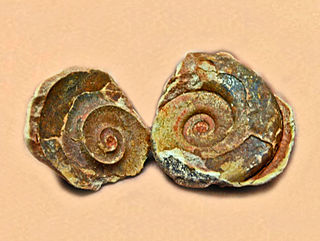Apleuroceras is a genus of ceratitid ammonites with an essentially smooth evolute shell with a subquadrade whorl section and a ceratitic suture with two lateral lobes. Apleuroceras belongs to the Aplococeratidae and has been found in middle Triassic formations of Ladinian age in Hungary and the Alps.

Aconeceras is an early Cretaceous ammonite included in the oppeliid subfamily Aconeceratidae, characterized by an involute, high-whorled, flat-sided shell that bears a finely serrate keel along the venter. Sutures have narrower and deeper elements than in Protaconeceras. Aconeceras has been found in western Europe, South Africa, and eastern Australia. Its stratigraphic range is from the Upper Barramian to the Lower Albian.
Xiphogymnites is an extinct ammonoid cephalopod genus from the Triassic included in the family Gymnitidae. It is known from the Balkans in eastern Europe.
Albanites is a genus of extinct cephalopods belonging to the ammonoid order Ceratitida that lived during the Early Triassic epoch.
Dobrogeites is a genus of ammonoids from the order Ceratitida, included in the family Megaphyllitidae that produced evolute compressed planispiral shells with rounded venters, inner whorls ornamented as in Tirolites, outer whorls smooth, suture with multiple smooth lobes; Initially found in Anisian sediments in Romania.
Beneckeia is a genus of Lower to Middle Triassic ammonites included in the ceratitid family Beneckeiidae found e.g. in Germany, Poland, and Israel. Beneckeia shells are compressed smooth oxycones, involute with sharp venters. Sutures are multilobed with small adventitious lobes.

Uptonia is an extinct ammonite from the Lower Jurassic that's included in the eoderoceratoidean family Polymorphitidae.

The Xenodiscidae are the earliest of the Ceratitida and comprise Middle and Upper Permian genera characterized by compressed, discoidal, evolute shells with rounded to acute venters and commonly with lateral ribs. Sutures are goniatitic to weakly ceratitic.
Thalassoceratidae a family of late Paleozoic ammonites included in the goniatitid superfamily Thalassoceratoidea along with the Bisatoceratidae. Some eight genera are included, although the specific number and exactly which depends on the particular classification.
Ussurites is an extinct ammonoid cephalopod genus belonging to the suborder Phylloceratina and is included in the family Ussuritidae. Its range is restricted to the early Middle Triassic, (Anisian)
The Ophiceratidae is a family in the ammonoid order Ceratitida from the Lower Triassic, previously included in the Otocerataceae but now placed in the Noritiaceae as revised.
Ceratitoidea, formerly Ceratitaceae, is an ammonite superfamily in order Ceratitida characterized in general by highly ornamented or tuberculate shells with ceratitic sutures that may become goniatitic or ammonitic in some offshoots.

Stephanoceratoidea, formerly Stephanocerataceae, is a superfamily of middle- upper Jurassic ammonoid cephalopods within the order Ammonitida containing diverse forms, generally with sharp ribbing and complex suture lines. Aptychi are believed to be mostly granular (Granulaptycus) or concentrically ribbed on the surface (Praestriaptychus)
Inyoites is an ammonoid genus from the Lower Triassic, included in the ceratitid family Inyoitidae.
The Hungaritidae comprises a family of ceratitid ammonites described in the Treatise,(Arkell et al. 1957), as involute compressed, discoidal, with keeled or sharpened venter, smooth to weakly costate. Sutures ceratitid, usually with numerous elements.
Dieneria is a genus of ceratitid ammonoid cephalopods from the Late Triassic of western North America with a smooth discoidal shall of which the venter is truncate and the suture simple. Only the first lateral lobe is slightly serrated, the other lobes entire (smooth)

Meekoceras is an extinct genus of ceratitid ammonites with a discoidal shell that lived during the Early Triassic Epoch.
Euomphaloceratinae is a subfamily of Upper Cretaceous ammonites included in the Acanthoceratidae, characterized by generally evolute shells with quadrate whorl sections that are strongly ribbed. Sutures are ammonitic, but not overly complex.
Binneyitidae is a family of Upper Cretaceous ammonoid cephalopods characterized by rather small, compressed, flat sided shells and sutures that tend to have deep, narrow, simple elements with parallel sides, that range from the upper Cenomanian into the lower Santonian.
Flickiidae is a family of dwarf ammonites with little ornament and very simples sutures known from small pyritic specimens found in middle Cretaceous deposits. Inclusion in the Acanthoceratoidea is tentative.




